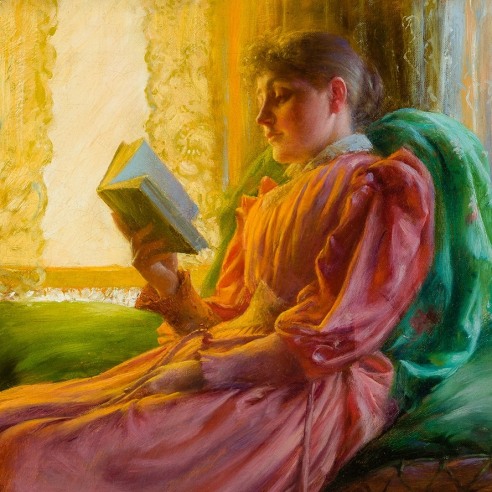
Charles Courtney Curran was born on February 13, 1861, in Hartford, Kentucky. Two months later, on April 12, 1861, Confederate gunners fired on Fort Sumter, South Carolina, and the Civil War began. Ulysses Curran, a teacher, and his wife Elizabeth were Union supporters. (While there are numerous brief biographical accounts of Curran, the book-length examination of this artist remains the Dixon exhibition catalogue cited above, with an essay by Jane Ward Paquin.) They soon moved North, first to Indiana, then to Ohio, finally settling in Sandusky, a railroad terminus and port town midway between Cleveland and Toledo on the south shore of Lake Erie. There they raised a family of two sons and two daughters and became prominent citizens. Ulysses served as superintendent of schools, and then, turning to law, as a Judge of the Erie County (Ohio) Court of Common Pleas. After graduating from Sandusky High School in 1879, and trying his hand at business, in 1881, Charles Curran enrolled at the McMicken School of Design in Cincinnati. The founder and principal teacher was Thomas Satterwhite Noble (1835–1907), a Kentucky native who had lived and studied in New York and in Paris with Thomas Couture. Noble left Cincinnati in 1881 for a two-year stay in Munich. Curran also left in 1881, bound for New York.
In 1882, Charles Curran enrolled in the school of the National Academy of Design, New York. He also sought instruction at the Art Students League, an insurgent institution founded in 1875 by younger, European-trained artists. It would continue to be a characteristic of Curran’s career that he committed to no doctrinal style, but widely observed and selectively absorbed influences from a variety of artists and influences. At the N.A.D. Curran studied with Walter Satterlee (1844–1908), a figure and genre painter. Curran gained quick recognition, honored as a student with the acceptance of his genre picture, A Quiet Smoke, for the 1883 Academy Annual Exhibition. Curran remained a stalwart of the N.A.D. for the rest of his life, exhibiting at an impressive 61 consecutive annual exhibitions, as well as nearly every winter exhibition from 1906 to 1932. He also exhibited regularly at the Art Institute of Chicago from 1888 to 1919; the Pennsylvania Academy of the Fine Arts, Philadelphia, from 1887 to 1935; the Boston Art Club from 1893 to 1909; and the Carnegie Institute’s International Exhibitions from 1896 to 1923.
Studying with Satterlee at the N.A.D. and Walter Shirlaw (1838–1909) at the Art Students League, Curran thrived in New York. In 1888, A Breezy Day gained him a Hallgarten Prize at the N.A.D. as well as election as an associate member of the Academy. In celebration, he went home and married his Ohio sweetheart, Grace Winthrop Wickham (1863–1850), the daughter of a member of the United States House of Representatives. (Grace Wickham Curran later served as librarian of the National Academy.) The Currans remained closely tied to family and their Ohio roots, returning to Ohio for summers for many years.
After a summer honeymoon in Ohio, the newly married couple went to Paris where they remained until 1891. Charles attended classes at the Académie Julian, popular with young American artists for its ease of access and flexibility of instruction outside the stricter regime of the Académie des Beaux-Arts. With a studio on the Left Bank of the Seine in Montparnasse and an apartment on the Île de la Cité, Curran explored all that Paris had to offer. The couple’s first child, Louis, was born there in 1889. Curran painted, socialized, and studied in Paris. He exhibited pictures at three Paris Salons, in 1889, 1890, and 1891 as well as showing at an 1891 exhibition organized at the Durand Ruel Gallery of works by American artists. His picture Lotus Lilies won an honorable mention at the 1890 Salon.
By the time that the Currans returned home in 1891, Curran was a fully trained professional artist ready to take his place in the mainstream of American artists. He established his home and studio in New York, spending summers for the next decade near his and Grace’s family in Ohio.
In 1903, the Currans first visited Cragsmoor, a summer artists’ colony on the highest ridge of the Shawangunk Mountains, in Ulster County, New York, just south of the Catskills. Founded by artist Edward Lamson Henry (1841–1919) in 1883, the Cragsmoor Colony became a favorite retreat for landscape painters attracted to its clear views of the surrounding mountains and valleys. Curran first stayed there as a guest of artist and writer Frederick Dellenbaugh and built his summer home there in 1908. William Gerdts records that “Cragsmoor enjoyed a new influx of ‘permanent visitors’ in the early years of this century. Charles Courtney Curran was undoubtedly the most renowned of this second generation” (Gerdts, Art Across America: Two Centuries of Regional Painting, vol. I [New York: Abrams, 1990], p. 167). Curran remained associated with Cragsmoor to the end of his life.
